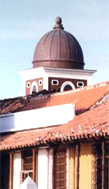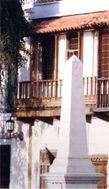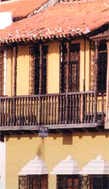SOMETHING OF HISTORY…

The real origins of Puerto Cabello still remain a mystery. The constant smuggling present in this area may be the conditioning factor for its foundation. Even though it is also unknown when did this geographical area started to be populated, some documents exist that account for its existence during the XVI century. Marco Aurelio Vila, following Dr. Miguel Acosta Saigenes makes a reference to a quoting from Juan Ruiz Ochoa, neighbour from the island La Española (1560) that mentions Puerto Cabello and indicates that it is still not populated. The port was visited regularly by French, English and Portuguese sailors to repair their ships. This is not the only reference we have available because Puerto Cabello is also mentioned in the Geographic Account and Description of the Province of Caracas and the Government of Venezuela by Juan Pimentel dated 1st December 1575.
So, the first settlements of Puerto Cabello could be found, taking as a basis statements from this author, in the barracks built by some Dutch fishermen and smugglers back in the XVI Century. The Castillian legend, on the other hand, attributes the name given to this site to the quietness of the waters, where a ship could be moored by one hair.
The appearance of the port was radically changed by the establishment of the Compañía Guipuzcoana at Puerto Cabello where Don Pedro de Olavarriaga was very much involved. Certainly, a product of one of the voyages made to the Province of Venezuela by this tireless Basque traveller during the years of 1720 and 1721 was the interesting "General and Particular Instruction on the Actual State of the Province of Venezuela"; the observations noted in this work are going to be determinant for the establishment of a dependence of the said company in this Port. "This port, with no doubts at all, must be considered as the best of these shores and may be the best in the whole of the Indies. It has a narrow entrance and a very appropriate bottom for all types of ships, even though it runs from West to East, (which is against the breeze), ships may enter it at any time because at all times they are towed. All needs for sailing are found here, and it may appear as if God, through his Divine Hands has wanted to save men the labour of adapting it to their needs because anyone wanting to improve it would have ruined it".
So, the first settlements of Puerto Cabello could be found, taking as a basis statements from this author, in the barracks built by some Dutch fishermen and smugglers back in the XVI Century. The Castillian legend, on the other hand, attributes the name given to this site to the quietness of the waters, where a ship could be moored by one hair.
The appearance of the port was radically changed by the establishment of the Compañía Guipuzcoana at Puerto Cabello where Don Pedro de Olavarriaga was very much involved. Certainly, a product of one of the voyages made to the Province of Venezuela by this tireless Basque traveller during the years of 1720 and 1721 was the interesting "General and Particular Instruction on the Actual State of the Province of Venezuela"; the observations noted in this work are going to be determinant for the establishment of a dependence of the said company in this Port. "This port, with no doubts at all, must be considered as the best of these shores and may be the best in the whole of the Indies. It has a narrow entrance and a very appropriate bottom for all types of ships, even though it runs from West to East, (which is against the breeze), ships may enter it at any time because at all times they are towed. All needs for sailing are found here, and it may appear as if God, through his Divine Hands has wanted to save men the labour of adapting it to their needs because anyone wanting to improve it would have ruined it".

Don Pedro de Olavarriaga was the first to talk about the reasons to strengthen Puerto Cabello ..." no other port is more convenient or deserves more strengthening than Puerto Cabello because of its location, because of the communications that provides with many other valleys, because it registers almost all other ports on these costs, because of the advantages of its terrain, and because it is easy to find there all materials necessary for construction of ships and also, because it offers ample and secure bays and the possibility to repair ships there as well as the possibility for building ships of any kind". Puerto Cabello witnessed the arrival, around 1730, of the first ships belonging to the Compañía Guipuzcoana and along with them, a legion of engineers, carpenters and masons that undertook the construction of the first roads, fortifications, aqueducts and other priority needs of the city, all this under the direction of the engineer Juan Amador Courten.
During the first years of the monopoly maintained by the Guipuzcoana, the principal occupation of the white Biscayne Spaniards were the conduction of commercial and navigation activities: when the commerce with the metropolis was opened in 1798 all that imported from Spain arrived in four of five ships during the year and they were used for the exportation at the same time, of different types of products to the Mother Land. When the Compañía Guipuzcoana disappears, Puerto Cabello already occupied an important place in the commercial relations between Spain and the Caribbean.
The War of Independence brought the destruction of a great portion of the city, and it also affected the commercial activity. Around 1823, once the city is free from the Spanish power the reconstruction is started, and the port initiates once more its daily activities. During 1868 a powerful lighthouse is constructed and the piers undergo some maintenance and repairs. Later in 1874, the President Guzman Blanco orders a complete repair of the piers, and the dredging of the bay. For this, machinery was specially acquired, capable to extract, according to experts, about 20,000 cubic meters from the bottom of the sea.
During the first years of the monopoly maintained by the Guipuzcoana, the principal occupation of the white Biscayne Spaniards were the conduction of commercial and navigation activities: when the commerce with the metropolis was opened in 1798 all that imported from Spain arrived in four of five ships during the year and they were used for the exportation at the same time, of different types of products to the Mother Land. When the Compañía Guipuzcoana disappears, Puerto Cabello already occupied an important place in the commercial relations between Spain and the Caribbean.
The War of Independence brought the destruction of a great portion of the city, and it also affected the commercial activity. Around 1823, once the city is free from the Spanish power the reconstruction is started, and the port initiates once more its daily activities. During 1868 a powerful lighthouse is constructed and the piers undergo some maintenance and repairs. Later in 1874, the President Guzman Blanco orders a complete repair of the piers, and the dredging of the bay. For this, machinery was specially acquired, capable to extract, according to experts, about 20,000 cubic meters from the bottom of the sea.

During the last decade of the XIX Century, the modern Puerto Cabello was built. The National Government invites several Venezuelan and foreign engineers to travel to Puerto Cabello in order to participate in the projects for the reconstruction of the piers. Amongst those engineers travels Norbert Paquet, a representative of a Belgium firm, who, after a study of the soil and the existent structures proposed the construction of a concrete wall with iron piles. After lengthy meetings and proposals, the project submitted by Paquet was accepted by the Government and a contract was signed by which the former would construct four hundred and fifty meters of piers, made up of a compound system of concrete constructions, iron piles and steel beams also protected by concrete. On 8th April 1897 the first section was finished and it was put into service immediately because of an urgent need to keep up with the commercial activity, but the totality of the works were completed three months later.
During the following decades, (1930-1980) and through the Servicios Portuarios Nacionales first, and the Instituto Nacional de Puertos later, both government entities, the port was enhanced with the addition of warehousing facilities and new piers for handling of general cargo. It is only after 1985 that the port reaches to its present physiognomy, after what is called Area VI was completed, in which berths are designed to handle the increasing traffic of containerised and bulk cargo.
During the following decades, (1930-1980) and through the Servicios Portuarios Nacionales first, and the Instituto Nacional de Puertos later, both government entities, the port was enhanced with the addition of warehousing facilities and new piers for handling of general cargo. It is only after 1985 that the port reaches to its present physiognomy, after what is called Area VI was completed, in which berths are designed to handle the increasing traffic of containerised and bulk cargo.
Source: José Alfredo Sabatino Pizzolante, "Historia y Presencia de una Cámara Centenaria", Cien años de la Cámara de Comercio de Puerto Cabello, 1997, 405 p.






